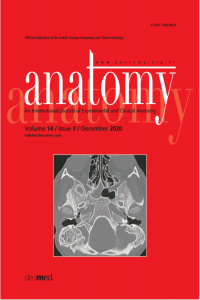Abstract
References
- Turney BW. Anatomy in a modern medical curriculum. Ann R Coll Surg Engl 2007;89:104–7.
- Sugand K, Abrahams P, Khurana A. The anatomy of anatomy: a review for its modernization. Anat Sci Educ 2010;3:83–93.
- Geleneksel ve Tamamlayıcı Tıp Uygulamaları Yönetmeliği. [Internet]. [Retrieved on May 26, 2020]. Available from: https://www.resmigazete.gov.tr/eskiler/2014/10/20141027-3.htm
- Türkiye Sağl›k Enstitüleri Baflkanlığı Kurulması ile Bazı Kanun ve Kanun Hükmünde Kararnamelerde Değişliklik Yapılmasına Dair Kanun. [Internet]. [Retrieved on May 26, 2020]. Available from: http://www.resmigazete.gov.tr/eskiler/2014/11/20141126-3.htm
- Peuker ET, White A, Ernst E, Pera F, Filler TJ. Traumatic complications of acupuncture. Therapists need to know human anatomy. Arch Fam Med 1999;8:553–8.
- Peuker E, Cummings M. Anatomy for the acupuncturist-facts & fiction 1: the head and neck region. Acupunct Med 2003;21:2–8.
- Standards of Education for Acupuncture. [Internet]. [Retrieved on May 26, 2020]. Available from: http://dosyasb.saglik.gov.tr/Eklenti/3971,akupunktur-egitim-standartlari-imzalananpdf.pdf
- Standards of Education for Apitherapy. [Internet]. [Retrieved on May 26, 2020]. Available from: http://dosyasb.saglik.gov.tr/Eklenti/3981,apiterapi-sertifikali-egitim-standartlaripdf.pdf
- Standards of Education for Osteopathy. [Internet]. [Retrieved on May 26, 2020]. Available from: http://www.istanbulsaglik.gov.tr/w/sb/duyurular/belge/osteopati_28112016.pdf
- Standards of Education for Ozone Therapy. [Internet]. [Retrieved on May 26, 2020]. Available from: http://dosyasb.saglik.gov.tr/Eklenti/3973,ozon-uygulamasi-sep-standartlaripdf.pdf
- Standards of Education for Prolotherapy. [Internet]. [Retrieved on May 26, 2020]. Available from: https://dosyasb.saglik.gov.tr/Eklenti/3986,proloterapi-sertifikali-egitim-standartlaripdf.pdf
- Standards of Education for Reflexology. [Internet]. [Retrieved on May 26, 2020]. Available from: http://istanbulsaglik.gov.tr/w/sb/duyurular/belge/refleksoloji_standart_sertf_egit_24112016.pdf
- Sağlık Bakanlığı. Geleneksel, Tamamlayıcı ve Alternatif Tıp Uygulamaları Yönetmeliği Taslak Metni. [Internet]. [Retrieved on May 26, 2020]. Available from: https://www.memurlar.net/common/news/documents/451139/gtat-yonetmelik-taslagi.pdf
- Standards of Education for Phytotherapy. [Internet]. [Retrieved on May 26, 2020]. Available from: http://dosyasb.saglik.gov.tr/Eklenti/3972,fitoterapi-sep---pdfpdf.pdf
- Standards of Education for Hypnosis. [Internet]. [Retrieved on May 26, 2020]. Available from: http://dosyasb.saglik.gov.tr/Eklenti/3983,hipnoz-sertifikali-egitim-standardipdf.pdf
- Standards of Education for Homeopathy. [Internet]. [Retrieved on May 26, 2020]. Available from: http://dosyasb.saglik.gov.tr/Eklenti/3974,homeopati-sertifikali-egitim-standartlaripdf.pdf
- Standards of Education for Cupping Therapy. [Internet]. [Retrieved on May 26, 2020]. Available from: http://dosyasb.saglik.gov.tr/Eklenti/3976,kupa-uygulamasi-sep-standartlari-1pdf.pdf
- Standards of Education for Maggot Therapy. [Internet]. [Retrieved on May 26, 2020]. Available from: http://dosyasb.saglik.gov.tr/Eklenti/3992,larvapdf.pdf
Abstract
Objectives: The aim of this study was to emphasize the amount of anatomy courses in the regulation titled, “Traditional and Complementary Medical Implementations” and to make anatomists think of the question who should teach anatomy in traditional and complementary medicine?
Methods: The anatomy courses in the standards of education for traditional and complementary therapies organized by the Turkish Republic Ministry of Health were investigated. The number of anatomy courses for teaching complementary medicine without standards of education were taken from the draft regulation for traditional and complementary therapies.
Results: Clinical anatomy is the practical application of anatomical knowledge to diagnosis and treatment. Up to date, there is no regulation defining who is authorized to give anatomy lectures in the workshops or courses permitted by the Ministry of Health of Turkey. It was seen that, theoretically, any health practitioner in workshops could give anatomy lectures.
Conclusion: Anatomists are experts of the structure and relationship of all parts of the body. A great number of anatomists are practicing traditional and complementary medicine in Turkey. The anatomists who are qualified in both anatomy and complementary medicine may be the ideal lecturers in the education of these methods.
Keywords
References
- Turney BW. Anatomy in a modern medical curriculum. Ann R Coll Surg Engl 2007;89:104–7.
- Sugand K, Abrahams P, Khurana A. The anatomy of anatomy: a review for its modernization. Anat Sci Educ 2010;3:83–93.
- Geleneksel ve Tamamlayıcı Tıp Uygulamaları Yönetmeliği. [Internet]. [Retrieved on May 26, 2020]. Available from: https://www.resmigazete.gov.tr/eskiler/2014/10/20141027-3.htm
- Türkiye Sağl›k Enstitüleri Baflkanlığı Kurulması ile Bazı Kanun ve Kanun Hükmünde Kararnamelerde Değişliklik Yapılmasına Dair Kanun. [Internet]. [Retrieved on May 26, 2020]. Available from: http://www.resmigazete.gov.tr/eskiler/2014/11/20141126-3.htm
- Peuker ET, White A, Ernst E, Pera F, Filler TJ. Traumatic complications of acupuncture. Therapists need to know human anatomy. Arch Fam Med 1999;8:553–8.
- Peuker E, Cummings M. Anatomy for the acupuncturist-facts & fiction 1: the head and neck region. Acupunct Med 2003;21:2–8.
- Standards of Education for Acupuncture. [Internet]. [Retrieved on May 26, 2020]. Available from: http://dosyasb.saglik.gov.tr/Eklenti/3971,akupunktur-egitim-standartlari-imzalananpdf.pdf
- Standards of Education for Apitherapy. [Internet]. [Retrieved on May 26, 2020]. Available from: http://dosyasb.saglik.gov.tr/Eklenti/3981,apiterapi-sertifikali-egitim-standartlaripdf.pdf
- Standards of Education for Osteopathy. [Internet]. [Retrieved on May 26, 2020]. Available from: http://www.istanbulsaglik.gov.tr/w/sb/duyurular/belge/osteopati_28112016.pdf
- Standards of Education for Ozone Therapy. [Internet]. [Retrieved on May 26, 2020]. Available from: http://dosyasb.saglik.gov.tr/Eklenti/3973,ozon-uygulamasi-sep-standartlaripdf.pdf
- Standards of Education for Prolotherapy. [Internet]. [Retrieved on May 26, 2020]. Available from: https://dosyasb.saglik.gov.tr/Eklenti/3986,proloterapi-sertifikali-egitim-standartlaripdf.pdf
- Standards of Education for Reflexology. [Internet]. [Retrieved on May 26, 2020]. Available from: http://istanbulsaglik.gov.tr/w/sb/duyurular/belge/refleksoloji_standart_sertf_egit_24112016.pdf
- Sağlık Bakanlığı. Geleneksel, Tamamlayıcı ve Alternatif Tıp Uygulamaları Yönetmeliği Taslak Metni. [Internet]. [Retrieved on May 26, 2020]. Available from: https://www.memurlar.net/common/news/documents/451139/gtat-yonetmelik-taslagi.pdf
- Standards of Education for Phytotherapy. [Internet]. [Retrieved on May 26, 2020]. Available from: http://dosyasb.saglik.gov.tr/Eklenti/3972,fitoterapi-sep---pdfpdf.pdf
- Standards of Education for Hypnosis. [Internet]. [Retrieved on May 26, 2020]. Available from: http://dosyasb.saglik.gov.tr/Eklenti/3983,hipnoz-sertifikali-egitim-standardipdf.pdf
- Standards of Education for Homeopathy. [Internet]. [Retrieved on May 26, 2020]. Available from: http://dosyasb.saglik.gov.tr/Eklenti/3974,homeopati-sertifikali-egitim-standartlaripdf.pdf
- Standards of Education for Cupping Therapy. [Internet]. [Retrieved on May 26, 2020]. Available from: http://dosyasb.saglik.gov.tr/Eklenti/3976,kupa-uygulamasi-sep-standartlari-1pdf.pdf
- Standards of Education for Maggot Therapy. [Internet]. [Retrieved on May 26, 2020]. Available from: http://dosyasb.saglik.gov.tr/Eklenti/3992,larvapdf.pdf
Details
| Primary Language | English |
|---|---|
| Subjects | Health Care Administration |
| Journal Section | Teaching Anatomy |
| Authors | |
| Publication Date | December 30, 2020 |
| Published in Issue | Year 2020 Volume: 14 Issue: 3 |
Cite
Anatomy is the official journal of Turkish Society of Anatomy and Clinical Anatomy (TSACA).


